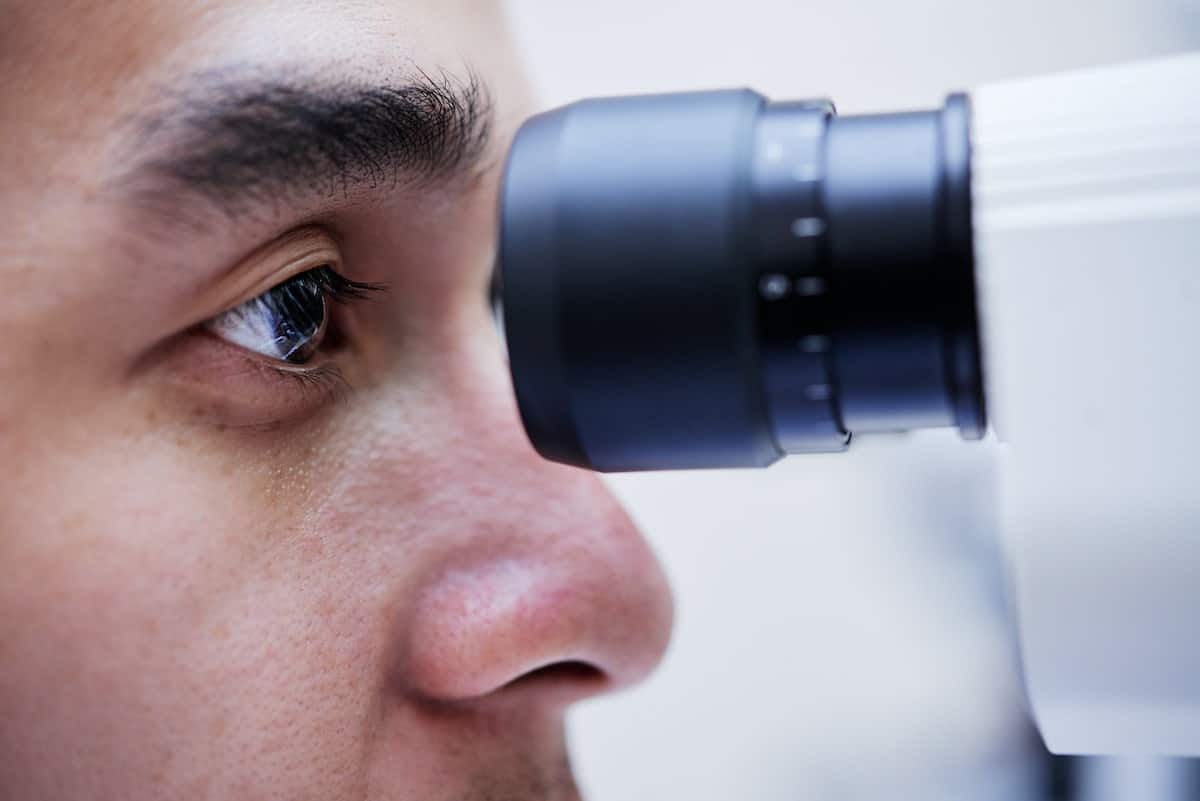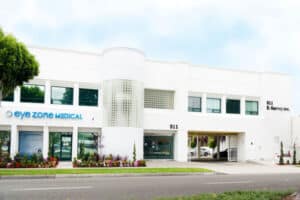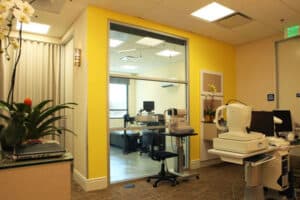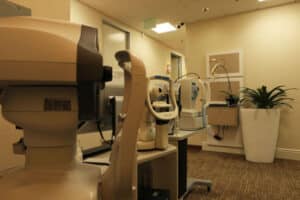Linda Vision is a leading vision practice offering comprehensive treatment and care to patients in Monterey Park and the surrounding Los Angeles area. Our surgeons have decades of experience treating pterygium and we are proud to have a high success rate. We also make every effort possible to reduce your risk of recurrence. Using state-of-the-art technologies, we will develop a treatment plan that is customized to your needs. It all starts with a free pterygium consultation, during which we will evaluate your condition and share more information about our Pterygium Promotional Program.
Linda Vision’s special Pterygium Promotional Program includes:
-
Natural graft to reduce the risk of pterygium recurrence
-
Full medical eye exam before pterygium surgery
-
Pterygium surgery recovery information
-
Follow-up pterygum checkups for 12 months after surgery with Dr. Linda Vu

Do I Have a Pterygium?
Depending on the size, you may or may not be able to tell if you have a pterygium. They tend to start out small and then slowly spread across the eye. At first they may not feel like anything, but then as they grow they can cause discomfort or the feeling of having something in your eye (like an eyelash). Ultimately, only an eye doctor can diagnose pterygium.
Preparing for Pterygium Surgery
The Assessment
During your initial consultation, your eyes will be thoroughly examined by one of our eye doctors to see if you are suitable for pterygium surgery. Prior to surgery, preoperative tests and a comprehensive health eye exam are performed to screen for glaucoma, cataracts, and other medical conditions. Possible risks and complications will also be discussed with the doctor. Once you have decided to undergo pterygium surgery, your procedure will be scheduled and you will be advised of your preoperative instructions. Plan to arrange transportation to and from our office for the day of surgery and for the day after surgery. You will also need to begin your antibiotic eye drops one day before surgery.
Day of Surgery
- You can eat and drink as usual, except for coffee or alcohol
- Do NOT wear makeup or lotion on your face
- Plan to shower no earlier than 24 hours after surgery
Ready to Schedule an Appointment?
We are committed to helping you achieve your visual goals and guarantee that we will safeguard your interests at all times.
Pterygium Symptoms
Although some people constantly feel like they have a foreign body in their eye, most are asymptomatic (show no symptoms) early on. The eyes can become red, irritated, itchy, and experience a burning sensation. Because the eyelids can no longer spread the tears over a smooth area, dry areas in the eye may result, which in turn causes even more irritation that promotes the continual growth of the pterygium. If a pterygium reaches a large size, it can also stretch and distort the cornea (clear front surface of the eye), inducing some astigmatism.
Chronic irritation or excessive exposure to UV light may cause the lesion to extend onto the cornea. Because pterygiums look like growths, people worry that they are malignant cancer. However, the underlying process is degeneration, and pterygiums do not invade the eye, sinuses, or brain. Most pterygiums are slow-growing and rarely cause significant problems like vision loss. Over time however, the growth of a pterygium can resemble tissue or film growing over the eye and can cause astigmatism.
Do I Have a Pterygium?
Depending on the size, you may or may not be able to tell if you have a pterygium. They tend to start out small and then slowly spread across the eye. At first they may not feel like anything, but then as they grow they can cause discomfort or the feeling of having something in your eye (like an eyelash). Ultimately, only an eye doctor can diagnose pterygium.
Is Surgery Necessary?
Although most pterygiums are harmless, they are surgically removed if they cause excessive discomfort, redness or visual problems. Surgery is also performed if a pterygium is unsightly or cosmetically unappealing. Patients in the Monterey Park area can visit Linda Vision for regular eye examinations with our eye doctors. They are able to tell if a pterygium is beginning to spread and will recommend having it removed as soon as possible with a graft.
About Pterygium
A pterygium (TER-i-gee-um), also known as carnosidad or pterigión in Spanish, is a fleshy, pink scar that sometimes crosses the cornea (the clear front window of the eye). One or both eyes may be involved and a patient can have more than one pterygium in each eye. Pterygiums can vary in size from small to large and are often visible on the eye before they cause symptoms.
Pterygiums are seen on the surface of the eye and are visibly noticeable even before they cause symptoms. Initially, the conjunctiva (clear mucous membrane that covers the white part of the eye) will thicken and look like a bump. This is called a pingueculum, and is the initial stage of a pterygium.
Pterygium Surgery with Linda Vision
Surgery is performed in-office under local anesthesia. This means that you will be awake, but we will numb your eyes so that you do not feel anything during surgery. The procedure takes about 20 minutes per pterygium.
The steps of the surgery are as follows:
- The pterygium and all thickened areas are removed (see “A” in illustration).
- An unaffected piece of your own white tissue (see “B” in illustration) is removed and grafted into the area where the pterygium was removed.
- Sutures are used to hold the graft in place.
- A clear bandage contact lens is placed in the eye for protection, but your eye will not be patched after surgery.

It is important to note that while the entire lesion is removed during surgery, the risk of recurrence is more than 50% unless special care is taken to prevent regrowth. A small area of unaffected white tissue is grafted to the area where the pterygium is removed, reducing the risk of recurrence to less than 5%. Sometimes, special medications or amniotic membrane grafts are also needed.
Ready to Schedule an Appointment?
We are committed to helping you achieve your visual goals and guarantee that we will safeguard your interests at all times.
Causes and Risk Factors of Pterygium and Pinguecula
Although the cause of pterygium is not completely understood, prolonged exposure to ultraviolet and infrared radiation from sunlight have been implicated. Other chronic irritants, such as dust and wind, may play a role as well. Pterygiums have also been genetically linked, as can be seen by their presence among members of the same family.
Preventative Measures
Since the exact cause of pterygiums is unknown, nothing can be done to prevent you from developing a lesion. However, there are multiple preventative measures that can help stop or slow their growth. It is possible to stop the growth of pinguecula and prevent them from turning into pterygiums by lubricating the eyes with artificial tears and shielding them from the sunlight. Eyes that are excessively dry and irritated are perfect environments for growing pterygiums.
Pterygium Surgery FAQS
A pterygium (TER-i-gee-um), also known as carnosidad or pterigión in Spanish, is a fleshy, pink scar that crosses the cornea. Symptoms include a foreign body sensation in the eye, irritation, itchiness, or a burning sensation. Large pterygiums can also distort the cornea, causing astigmatism.
The exact cause is unknown but it is associated with excessive exposure to ultraviolet light from the sun. Chronic irritants like dust and wind may also promote pterygium growth.
The surgery is performed in the office, under local anesthesia. The entire lesion is removed, but there is more than a 50% risk of recurrence unless special care is taken to prevent regrowth. A small area of white, unaffected tissue is grafted to the area where the pterygium is removed, reducing the risk of recurrence to less than 5%. Sometimes, special medications or amniotic membrane grafts are also needed.
During surgery, your eyes will be completely numb and you will not be able to feel anything. After surgery, when the anesthesia begins to wear off, you will experience some discomfort. Generally, over-the-counter Tylenol along with lubricating eye drops are sufficient to alleviate symptoms.
Consult with our eye doctors for information on what to expect from your pterygium surgery recovery. Immediately after surgery you may experience a foreign body sensation and watering in the eyes. Patients usually spend at least 24 hours after surgery resting. Healing after this type of surgery may take a few weeks, during which you will use prescription eye drops. The eye may be slightly swollen and bloodshot for about 3-4 weeks, but its appearance as well as any discomfort improve over time.
Although most pterygiums are harmless, they are surgically removed if they cause excessive discomfort, redness or visual problems. Surgery is also performed if a pterygium is unsightly or cosmetically unappealing.
The length of surgery depends on several factors, including the complexity of each patient’s pterygium. Generally, surgery takes about 20 minutes per pterygium.
No. You should arrange transportation from our office to your home after surgery. You will be given Valium prior to your surgery which can cause drowsiness and affect your ability to drive. We also recommend that you have someone drive you to your first post-operative appointment the following day.
Your eye will look very red for 1-2 weeks after surgery. Usually, patients start to notice less redness 2-3 weeks after surgery. Some patients heal faster, while others take longer. However, at 3-6 weeks you will see that you are well on your way to recovery.
All surgeries have risks, but the vast majority of pterygium surgeries go perfectly well with excellent results and satisfied patients. Our eye surgeons will answer all your questions and discuss any possible risks, including bleeding and infection, with you before surgery. Most patients experience some discomfort for a few days to a week after the surgery. There may be some temporary sensitivity to bright light or wind, and we recommend wearing dark glasses when outdoors.
New techniques have significantly reduced healing times. However, each patient’s healing time varies depending on the type of procedure performed, medical history, and physical health. You can expect to go back to work within 1 week of surgery. Your eyes will continue to heal over the next 2-4 months. You will be using prescribed eye drops to help in your recovery and to reduce the chances of your pterygium recurring.
The cost to remove your pterygium depends on many factors, including:
- The size and thickness of the pterygium
- The location of the pterygium
- The number of pterygiums you have in each eye
- Whether you have enough natural tissue to perform a graft or whether an amniotic membrane graft needs to be used
- Whether you had previous surgery to remove your pterygium
Linda Vision also offers interest-free financing through CareCredit. We recommend you come in for a free pterygium consultation at our state-of-the-art eye surgery center in Los Angeles so that one of our eye doctors can look at your eye(s) and determine the best treatment plan for your specific case.
Yes, we offer 0% interest monthly payments through CareCredit that make pterygium surgery easily affordable.
QUALITY CARE WITH LINDA VISION
Our Los Angeles LASIK specialists have been performing LASIK surgeries for over 20 years combined, with very positive results. Linda Vision’s experience and dedication to each patient, along with the use of the Wavelight EX500 excimer laser, make Linda Vision the ideal place to have LASIK surgery. We offer unlimited LASIK follow-up exams for 12 months after your Custom Wavefront LASIK surgery.







